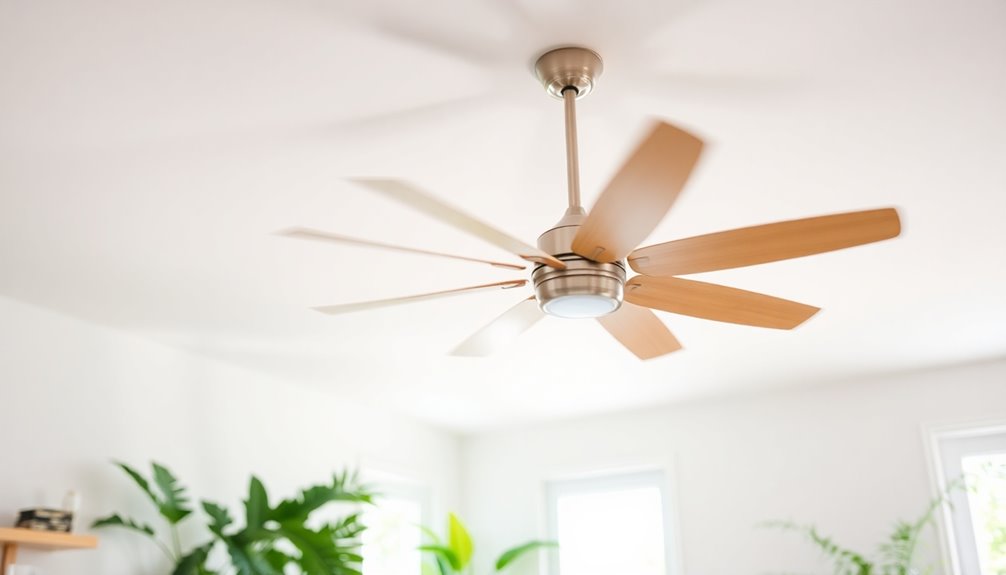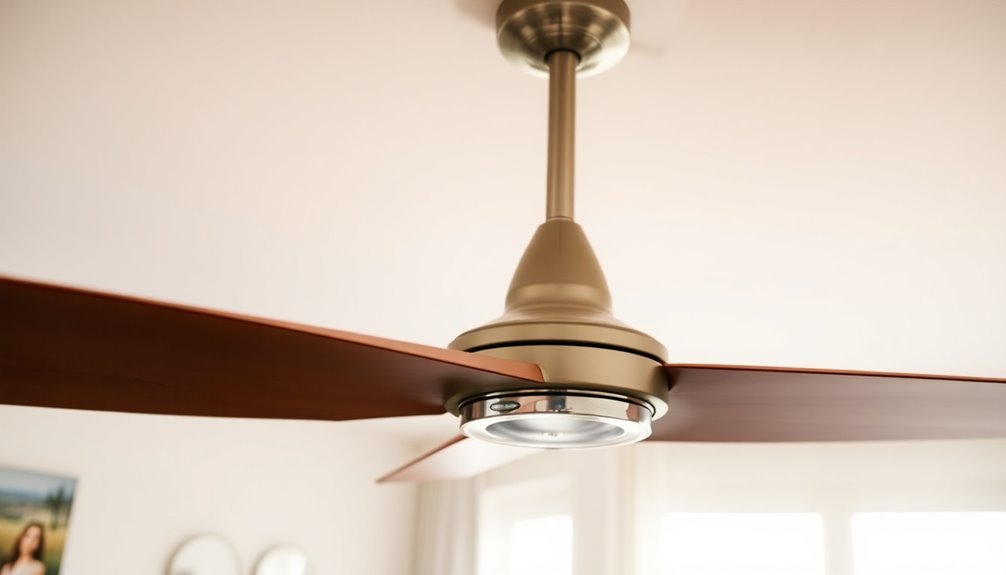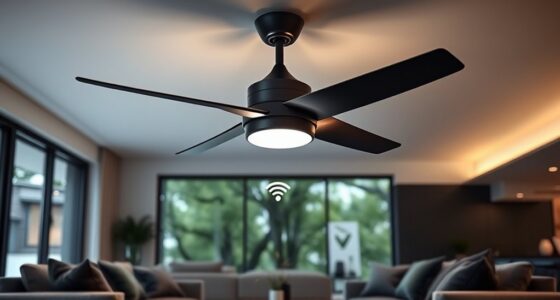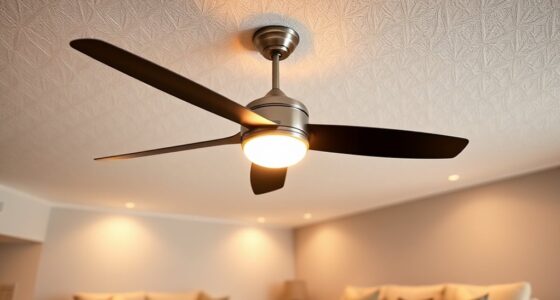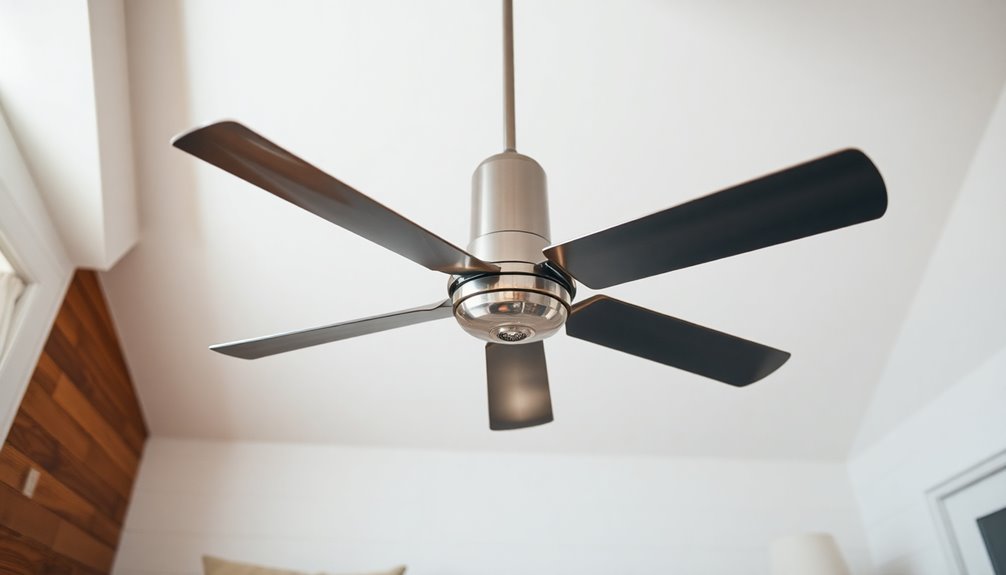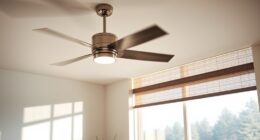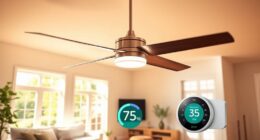To keep your home cool in the summer, you should set your ceiling fan to spin counterclockwise. This direction creates a revitalizing downdraft that can drop the perceived temperature by 4°F to 6°F, helping you feel cooler without cranking up the AC. Plus, running your fan in this direction can lower your energy costs by up to 30%. Make sure to adjust your fan's speed to maximize the airflow. If you're curious about how to change the fan's direction or additional energy-saving tips, there's plenty more to explore to enhance your comfort this summer.
Key Takeaways
- Set your ceiling fan to spin counterclockwise during summer to create a cooling downdraft effect.
- Counterclockwise rotation can lower perceived temperatures by 4°F to 6°F, enhancing comfort.
- Operating fans in this direction can reduce energy costs by up to 30% compared to air conditioning.
- Use high-speed settings for maximum airflow and cooling performance during hot months.
- Remember to switch to clockwise in fall to circulate warm air effectively.
Importance of Ceiling Fan Direction

When it comes to comfort in your home, the direction of your ceiling fan plays an essential role. Adjusting your ceiling fan direction to rotate counterclockwise during the summer can make a noticeable difference. This rotation creates a downdraft that produces a cooling breeze, enhancing your comfort while keeping the air circulating throughout the room.
Running your fan in this direction at high speed can greatly lower your energy costs. You mightn't realize that by allowing your thermostat to be set higher without sacrificing comfort, you can save up to 30% on energy bills. Proper air circulation is key in maintaining a consistent temperature, making your living space feel cooler and more pleasant. Additionally, utilizing heat pumps can further enhance your home's energy efficiency during the warmer months.
To reap these benefits, don't forget to regularly check and adjust your fan's direction as the seasons change. A simple twist of the switch can guarantee you're maximizing the cooling effects in summer, leading to a more enjoyable indoor climate.
Optimal Direction for Summer

Adjusting your ceiling fan to rotate counterclockwise in summer is key to maximizing your comfort. This ceiling fan direction creates a downdraft effect that produces a revitalizing cooling breeze, making you feel cooler without cranking up the air conditioning.
In fact, running your fan counterclockwise can lower perceived temperatures by up to 4 degrees Fahrenheit, allowing you to set your thermostat higher while still enjoying a comfortable environment.
By taking advantage of this wind chill effect, you'll enhance air circulation throughout the room, leading to better overall air quality. Additionally, using heat pumps can further improve your indoor air quality and energy efficiency during the summer months.
Plus, using your ceiling fan this way can save you energy costs by up to 30%. That's a significant reduction that benefits both your wallet and the environment.
To check if your fan is spinning correctly for summer, stand beneath it and feel the airflow. If it feels like a cool breeze blowing down, you've got it right!
Embrace the summer with the ideal ceiling fan direction, and enjoy the cooling benefits it provides.
How to Change Fan Direction

Changing the direction of your ceiling fan is a straightforward task that can make a big difference in your comfort.
To start, always verify your ceiling fan is turned off before making any adjustments for safety. If you have a fan with a pull chain, locate the ceiling fan switch on the fan body and slide it to change the direction. You should switch it to rotate counterclockwise for ideal fan direction in summer.
Once adjusted, turn the fan back on and enjoy the cooling effect.
For remote-controlled fans, turn it off first, then press and hold the reverse button until the light blinks. After that, turn the fan back on.
If you're using a smart ceiling fan, you can change the direction through a compatible app or voice command, but again, make certain the fan is powered off first.
Effects of Counterclockwise Rotation

When your ceiling fan rotates counterclockwise in summer, you'll experience a noticeable cooling effect as it pushes air downward.
This motion not only makes the room feel cooler but also improves air circulation, leading to a more consistent temperature throughout your space.
Enhanced Cooling Effect
To maximize your comfort during the hot summer months, it's vital to set your ceiling fan to rotate counterclockwise. This counterclockwise direction creates a downdraft, generating a cooling breeze that considerably lowers perceived temperatures in your space.
You'll notice that as the fan spins, it produces a wind-chill effect, allowing you to feel cooler without cranking up the air conditioning.
By using your ceiling fan effectively, you can reduce energy costs by up to 30%, as it allows your air conditioning system to work less frequently. When the fan operates at high speed, it enhances airflow, ensuring a consistent and comfortable room temperature throughout the day.
Standing directly beneath a fan rotating counterclockwise, you should feel a noticeable airflow, which signals effective cooling performance. This enhanced air circulation not only keeps your environment pleasant but also makes it easier to maintain your preferred climate without over-relying on cooling systems.
Embracing this simple adjustment can help you enjoy a rejuvenating atmosphere while saving on energy expenses, making your summer more enjoyable and budget-friendly.
Improved Air Circulation
Setting your ceiling fan to rotate counterclockwise not only enhances cooling effects but also notably improves air circulation throughout your space. When the fan spins in this direction during the summer heat, it creates a downdraft that pushes cool air down, making your living area more comfortable.
This counterclockwise rotation can lower perceived temperatures by up to 10 degrees Fahrenheit, allowing you to feel cooler without touching the thermostat.
Moreover, running your ceiling fan at high speed in the counterclockwise direction boosts the wind-chill effect, which improves overall air circulation. This guarantees that cool air is evenly distributed, maintaining a consistent room temperature.
With proper ceiling fan direction, you can considerably reduce reliance on air conditioning, potentially saving energy costs by up to 30%.
Incorporating a ceiling fan into your cooling strategy not only combats the sweltering summer heat but also enhances your indoor environment, leading to a more pleasant atmosphere.
Benefits of Ceiling Fans With AC

Comfort is key during the sweltering summer months, and ceiling fans can greatly enhance the efficiency of your air conditioning system. By using a ceiling fan in conjunction with your AC, you can distribute cool air more evenly throughout the room.
This means you can set your thermostat a few degrees higher without sacrificing comfort, which can considerably lower your energy bills.
You'll appreciate how ceiling fans create a wind-chill effect, making you feel cooler even when the air conditioning isn't set to its lowest temperature. With a ceiling fan consuming approximately 50 watts compared to the 3,500 watts of an AC unit, you're making a cost-effective choice to save energy.
In fact, pairing them can reduce energy costs by up to 8%!
Another benefit is that the right ceiling fan direction can further enhance air circulation. During the summer, set your fan to rotate counterclockwise for a revitalizing breeze that cools you down.
Timing for Direction Change

As summer approaches, it's time to switch your ceiling fan to counterclockwise for that invigorating downdraft.
A great reminder for this change is during Daylight Savings Time—set it to counterclockwise in spring and back to clockwise in fall. Proper sizing of heat pumps can further optimize your home's temperature control during the warmer months. Additionally, ensuring your air purifier is well-maintained can greatly enhance indoor air quality, making your home more comfortable during the hot season. Utilizing geothermal heat pumps can also provide significant energy savings and improve your home's overall efficiency. Implementing a reliable home security system can also give you peace of mind while you enjoy the summer weather.
Regularly checking your fan's direction guarantees ideal airflow and comfort year-round. Additionally, using a ceiling fan can complement your heat pump system, enhancing energy efficiency while keeping your home comfortable.
Seasonal Reminder Adjustments
A great way to remember to adjust your ceiling fan direction is to align it with Daylight Savings Time.
When spring rolls around, change your ceiling fans to rotate counterclockwise. This direction creates a cooling downdraft, which helps enhance your comfort while reducing reliance on air conditioning.
In the fall, reverse the direction to clockwise to push warm air trapped near the ceiling down into your living space.
Making these seasonal adjustments twice a year is key to maximizing energy efficiency. Regularly changing the direction a ceiling fan can lead to energy savings of up to 30% in cooling costs during the hotter months.
Before you get started, always verify the fan is turned off to prevent any accidents while making the adjustments.
Optimal Fan Settings
Adjusting your ceiling fan settings for summer can greatly enhance your indoor environment. To keep cool during the warmer months, you should set your ceiling fan blades to spin counterclockwise. This direction creates a rejuvenating downdraft that considerably improves air circulation, helping you feel more comfortable without over-relying on air conditioning.
The ideal time to change the direction of your fans is during Daylight Savings Time when you move the clocks forward in spring. By making this switch, you guarantee your fan is ready to combat summer heat effectively.
Keeping the fan on high speed while spinning counterclockwise maximizes the distribution of cool air, maintaining a pleasant indoor temperature.
Regularly adjusting your ceiling fan direction guarantees consistent airflow throughout the room, which can even help reduce your energy costs by up to 30%.
Specific Room Considerations

How can you optimize your ceiling fan's direction for different rooms? Adjusting your ceiling fan's blades can greatly enhance airflow depending on where you are in your home. Here's a quick guide to help you decide on the best settings:
| Room Type | Fan Direction |
|---|---|
| Vaulted Ceilings | Counterclockwise |
| Dining Room | Counterclockwise |
| Home Office | Medium Counterclockwise |
| Living Room (Smokers) | Clockwise |
| Outdoor Ceiling Fan | Counterclockwise at high speed |
In rooms with vaulted ceilings, keeping the fan on counterclockwise year-round guarantees a consistent airflow. In your dining room, this same setting maintains a comfortable temperature without cooling your food too quickly. For your home office, a medium counterclockwise setting prevents papers from blowing around while still keeping you comfortable. If you have smokers in your living space, switching to clockwise helps draw smoke upward, improving air quality. Finally, remember to set your outdoor ceiling fan to counterclockwise at high speed to maximize airflow and keep pesky insects at bay during those hot summer days.
General Ceiling Fan Tips

To get the most out of your ceiling fan, proper installation and regular maintenance are key.
Make sure your fan is set to spin counterclockwise in the summer for ideal cooling.
Keeping the blades clean not only boosts performance but also helps you save on energy costs.
Installation and Maintenance Tips
Installing and maintaining your ceiling fan properly can greatly enhance its performance and longevity. To achieve ideal airflow, install your fan 7-9 feet above the floor. This height not only guarantees safety but also maximizes efficiency. Properly installed fans can also help with contrast ratios in home theater setups by circulating air effectively.
Make sure there's at least 10 inches of clearance between the fan blades and the ceiling, allowing for better operation and airflow. Position your fan at least 18 inches away from walls to promote proper air circulation.
If you have vaulted ceilings, consider using down rods to reach the right height for your fan. This adjustment will help maximize airflow effectiveness, keeping your space comfortably cool.
Regular maintenance is key. Check and tighten all screws and bolts periodically to prevent wobbling while the fan is in operation. A well-maintained fan operates more efficiently, reducing wear and tear over time. Additionally, selecting a fan that aligns with your home's airflow efficiency can further enhance comfort and energy savings.
Energy Efficiency Benefits
Ceiling fans offer significant energy efficiency benefits that can help you save money while keeping your home comfortable during summer.
Running your ceiling fan counterclockwise creates a cooling downdraft effect, making the air feel cooler without actually lowering the room temperature. This simple switch can reduce your energy costs by up to 30%!
A ceiling fan uses about 50 watts of power, while air conditioning units average around 3,500 watts. Additionally, modern Energy Star certified fans can increase thermostat temperature by 4°F, further enhancing your energy savings.
Energy Savings With Proper Use

When you set your ceiling fan to spin counterclockwise in the summer, you can considerably reduce your energy costs. This simple adjustment creates a cooling downdraft, allowing you to raise your thermostat by 4 degrees without sacrificing comfort.
By using your ceiling fan properly, you can enjoy significant savings compared to relying solely on air conditioning.
Here are three ways to maximize your energy savings:
- Lower AC Usage: Pair your ceiling fan with an ENERGY STAR-rated air conditioning unit for an additional 8% savings. The wind-chill effect from the fan allows you to feel cooler even at higher thermostat settings.
- Energy-Efficient Alternative: Running a ceiling fan only consumes about 50 watts, a stark contrast to the 3,500 watts typical in air conditioning units. This makes it an energy-efficient option for air circulation in your home.
- Seasonal Adjustments: Regularly adjust the fan's direction with the changing seasons. This optimizes energy savings and maximizes airflow, ensuring your home remains comfortable year-round.
Implementing these tips with your ceiling fan can lead to substantial energy savings while enhancing your overall comfort.
Maintaining Your Ceiling Fan

Proper maintenance of your ceiling fan not only keeps it running efficiently but also enhances the energy savings you gain during the summer months.
To start, regularly clean the fan blades to remove dust and debris. This simple task can improve airflow and energy efficiency by up to 30%.
Next, inspect the fan's motor and components for any unusual noises or signs of wear, as these can indicate maintenance needs.
It's also essential to check and tighten all screws and bolts periodically. This prevents wobbling and guarantees safe operation.
Make sure the fan is installed correctly, maintaining a minimum clearance of 10 inches between the blades and the ceiling for peak performance.
Lastly, follow the manufacturer guidelines for maintenance routines and recommended cleaning products to extend the lifespan of your ceiling fan.
By consistently maintaining your fan, you'll not only enhance its performance but also enjoy a cooler environment while saving on energy costs.
Take these steps, and your ceiling fan will work efficiently through the hottest months, keeping you comfortable and reducing your energy bills.
Frequently Asked Questions
How Do You Tell if a Fan Is Going Clockwise or Counterclockwise?
To tell if your fan's going clockwise or counterclockwise, stand directly underneath it and watch the blade rotation.
If the blades move from left to right, it's counterclockwise. You can also feel the airflow; a nice breeze means it's spinning counterclockwise, while still air indicates clockwise.
If you're unsure, check for a directional switch on the fan body or remote, or refer to your owner's manual for guidance.
Which Direction Ceiling Fan in Summer?
Did you know running a ceiling fan can cut your air conditioning costs by up to 30%?
To maximize comfort during summer, you should set your fan to spin counterclockwise. This direction creates a cooling downdraft, producing a revitalizing breeze that can make your room feel up to 4 degrees cooler.
Just stand under the fan; if you feel a noticeable breeze, you've got it right. Enjoy the summer chill!
Which Way for a Fan in Winter?
In winter, you should set your ceiling fan to spin clockwise.
This direction creates a gentle updraft, pushing warm air down from the ceiling where it tends to accumulate.
By running the fan at a low speed, you can avoid drafts while redistributing warmth throughout the room.
This simple adjustment can help maintain a consistent and cozy indoor temperature, enhancing your comfort and potentially saving on heating costs.
What Direction Should I Face My Fan?
Imagine standing in a vintage diner, sipping a cold soda while the ceiling fan spins above.
You should face your fan to direct airflow where you need it most. If you want a rejuvenating breeze, angle it downward, creating a cool downdraft.
If you're looking to circulate warm air, point it upward. Adjusting the fan's direction lets you control the comfort of your space, making your environment just right.
Conclusion
In summer, setting your ceiling fan to spin counterclockwise is like opening a window to a cool breeze on a hot day. This simple adjustment enhances airflow and helps you feel cooler without cranking up the AC. Remember to regularly maintain your fan for peak performance and energy savings. By using your ceiling fan wisely, you can enjoy a rejuvenating atmosphere while keeping your energy bills in check. Stay cool and comfortable all summer long!
